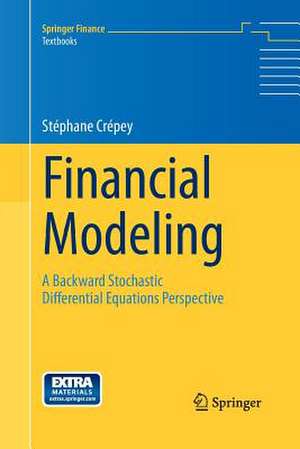Financial Modeling: A Backward Stochastic Differential Equations Perspective: Springer Finance
Autor Stephane Crepeyen Limba Engleză Paperback – 10 iul 2015
Stéphane Crépey’s book starts with a few chapters on classical stochastic processes material, and then... fasten your seatbelt... the author starts traveling backwards in time through backward stochastic differential equations (BSDEs). This does not mean that one has to read the book backwards, like a manga! Rather, the possibility to move backwards in time, even if from a variety of final scenarios following a probability law, opens a multitude of possibilities for all those pricing problems whose solution is not a straightforward expectation. For example, this allows for framing problems like pricing with credit and funding costs in a rigorous mathematical setup. This is, as far as I know, the first book written for several levels of audiences, with applications to financial modeling and using BSDEs as one of the main tools, and as the song says: "it's never as good as the first time".
Damiano Brigo, Chair of Mathematical Finance, Imperial College London
While the classical theory of arbitrage free pricinghas matured, and is now well understood and used by the finance industry, the theory of BSDEs continues to enjoy a rapid growth and remains a domain restricted to academic researchers and a handful of practitioners. Crépey’s book presents this novel approach to a wider community of researchers involved in mathematical modeling in finance. It is clearly an essential reference for anyone interested in the latest developments in financial mathematics.
Marek Musiela, Deputy Director of the Oxford-Man Institute of Quantitative Finance
| Toate formatele și edițiile | Preț | Express |
|---|---|---|
| Paperback (1) | 479.82 lei 6-8 săpt. | |
| Springer Berlin, Heidelberg – 10 iul 2015 | 479.82 lei 6-8 săpt. | |
| Hardback (1) | 540.24 lei 6-8 săpt. | |
| Springer Berlin, Heidelberg – 19 iun 2013 | 540.24 lei 6-8 săpt. |
Din seria Springer Finance
- 24%
 Preț: 703.47 lei
Preț: 703.47 lei - 17%
 Preț: 361.15 lei
Preț: 361.15 lei - 13%
 Preț: 359.67 lei
Preț: 359.67 lei - 24%
 Preț: 605.30 lei
Preț: 605.30 lei - 24%
 Preț: 809.77 lei
Preț: 809.77 lei - 18%
 Preț: 787.15 lei
Preț: 787.15 lei - 17%
 Preț: 398.82 lei
Preț: 398.82 lei - 15%
 Preț: 649.06 lei
Preț: 649.06 lei - 18%
 Preț: 937.37 lei
Preț: 937.37 lei - 18%
 Preț: 1108.36 lei
Preț: 1108.36 lei - 15%
 Preț: 659.85 lei
Preț: 659.85 lei -
 Preț: 387.75 lei
Preț: 387.75 lei - 18%
 Preț: 801.17 lei
Preț: 801.17 lei - 15%
 Preț: 658.88 lei
Preț: 658.88 lei - 15%
 Preț: 651.19 lei
Preț: 651.19 lei - 18%
 Preț: 1112.60 lei
Preț: 1112.60 lei - 18%
 Preț: 937.86 lei
Preț: 937.86 lei -
 Preț: 418.34 lei
Preț: 418.34 lei -
 Preț: 398.15 lei
Preț: 398.15 lei - 15%
 Preț: 597.01 lei
Preț: 597.01 lei - 15%
 Preț: 637.89 lei
Preț: 637.89 lei - 18%
 Preț: 939.62 lei
Preț: 939.62 lei -
 Preț: 385.84 lei
Preț: 385.84 lei - 18%
 Preț: 892.90 lei
Preț: 892.90 lei -
 Preț: 395.25 lei
Preț: 395.25 lei - 15%
 Preț: 497.45 lei
Preț: 497.45 lei - 15%
 Preț: 632.19 lei
Preț: 632.19 lei - 18%
 Preț: 737.26 lei
Preț: 737.26 lei - 15%
 Preț: 644.95 lei
Preț: 644.95 lei - 15%
 Preț: 593.55 lei
Preț: 593.55 lei - 18%
 Preț: 1207.45 lei
Preț: 1207.45 lei - 18%
 Preț: 810.81 lei
Preț: 810.81 lei -
 Preț: 391.61 lei
Preț: 391.61 lei - 19%
 Preț: 506.25 lei
Preț: 506.25 lei - 18%
 Preț: 957.62 lei
Preț: 957.62 lei -
 Preț: 387.75 lei
Preț: 387.75 lei - 15%
 Preț: 503.37 lei
Preț: 503.37 lei - 15%
 Preț: 593.91 lei
Preț: 593.91 lei -
 Preț: 383.71 lei
Preț: 383.71 lei
Preț: 479.82 lei
Preț vechi: 564.49 lei
-15% Nou
Puncte Express: 720
Preț estimativ în valută:
91.83€ • 94.86$ • 76.42£
91.83€ • 94.86$ • 76.42£
Carte tipărită la comandă
Livrare economică 25 martie-08 aprilie
Preluare comenzi: 021 569.72.76
Specificații
ISBN-13: 9783642442520
ISBN-10: 3642442528
Pagini: 480
Ilustrații: XIX, 459 p.
Dimensiuni: 155 x 235 x 30 mm
Greutate: 0.67 kg
Ediția:2013
Editura: Springer Berlin, Heidelberg
Colecția Springer
Seriile Springer Finance, Springer Finance Textbooks
Locul publicării:Berlin, Heidelberg, Germany
ISBN-10: 3642442528
Pagini: 480
Ilustrații: XIX, 459 p.
Dimensiuni: 155 x 235 x 30 mm
Greutate: 0.67 kg
Ediția:2013
Editura: Springer Berlin, Heidelberg
Colecția Springer
Seriile Springer Finance, Springer Finance Textbooks
Locul publicării:Berlin, Heidelberg, Germany
Public țintă
GraduateCuprins
Part I: An Introductory Course in Stochastic Processes.- 1.Some classes of Discrete-Time Stochastic Processes.-2.Some Classes of Continuous-Time Stochastic Processes.- 3.Elements of Stochastic Analysis.- Part II: Pricing Equations.- 4.Martingale Modeling.- 5.Benchmark Models.- Part III: Numerical Solutions.- 6.Monte Carlo Methods.- 7.Tree Methods.- 8.Finite Differences.- 9.Callibration Methods.- Part IV: Applications.- 10.Simulation/ Regression Pricing Schemes in Diffusive Setups.- 11.Simulation/ Regression Pricing Schemes in Pure Jump Setups.- Part V: Jump-Diffusion Setup with Regime Switching (**).- 12.Backward Stochastic Differential Equations.- 13.Analytic Approach.- 14.Extensions.- Part VI: Appendix.- A.Technical Proofs (**).- B.Exercises.- C.Corrected Problem Sets.
Textul de pe ultima copertă
Backward stochastic differential equations (BSDEs) provide a general mathematical framework for solving pricing and risk management questions of financial derivatives. They are of growing importance for nonlinear pricing problems such as CVA computations that have been developed since the crisis. Although BSDEs are well known to academics, they are less familiar to practitioners in the financial industry. In order to fill this gap, this book revisits financial modeling and computational finance from a BSDE perspective, presenting a unified view of the pricing and hedging theory across all asset classes. It also contains a review of quantitative finance tools, including Fourier techniques, Monte Carlo methods, finite differences and model calibration schemes. With a view to use in graduate courses in computational finance and financial modeling, corrected problem sets and Matlab sheets have been provided.
Stéphane Crépey’s book starts with a few chapters on classical stochastic processes material, and then... fasten your seatbelt... the author starts traveling backwards in time through backward stochastic differential equations (BSDEs). This does not mean that one has to read the book backwards, like a manga! Rather, the possibility to move backwards in time, even if from a variety of final scenarios following a probability law, opens a multitude of possibilities for all those pricing problems whose solution is not a straightforward expectation. For example, this allows for framing problems like pricing with credit and funding costs in a rigorous mathematical setup. This is, as far as I know, the first book written for several levels of audiences, with applications to financial modeling and using BSDEs as one of the main tools, and as the song says: "it's never as good as the first time".
Damiano Brigo, Chair of Mathematical Finance, Imperial College London
While the classical theory of arbitrage free pricinghas matured, and is now well understood and used by the finance industry, the theory of BSDEs continues to enjoy a rapid growth and remains a domain restricted to academic researchers and a handful of practitioners. Crépey’s book presents this novel approach to a wider community of researchers involved in mathematical modeling in finance. It is clearly an essential reference for anyone interested in the latest developments in financial mathematics.
Marek Musiela, Deputy Director of the Oxford-Man Institute of Quantitative Finance
Stéphane Crépey’s book starts with a few chapters on classical stochastic processes material, and then... fasten your seatbelt... the author starts traveling backwards in time through backward stochastic differential equations (BSDEs). This does not mean that one has to read the book backwards, like a manga! Rather, the possibility to move backwards in time, even if from a variety of final scenarios following a probability law, opens a multitude of possibilities for all those pricing problems whose solution is not a straightforward expectation. For example, this allows for framing problems like pricing with credit and funding costs in a rigorous mathematical setup. This is, as far as I know, the first book written for several levels of audiences, with applications to financial modeling and using BSDEs as one of the main tools, and as the song says: "it's never as good as the first time".
Damiano Brigo, Chair of Mathematical Finance, Imperial College London
While the classical theory of arbitrage free pricinghas matured, and is now well understood and used by the finance industry, the theory of BSDEs continues to enjoy a rapid growth and remains a domain restricted to academic researchers and a handful of practitioners. Crépey’s book presents this novel approach to a wider community of researchers involved in mathematical modeling in finance. It is clearly an essential reference for anyone interested in the latest developments in financial mathematics.
Marek Musiela, Deputy Director of the Oxford-Man Institute of Quantitative Finance
Caracteristici
Provides a unique, BSDE-based perspective on financial modeling and computational finance areas as for example on the pricing and hedging theory, across all asset classes A unified presentation of all kinds of numerical schemes: semi-explicit, deterministic (PDEs), simulation (Monte Carlo and American Monte Carlo) Illustrates both the theoretical and practical interest of BSDEs for financial applications? Request lecturer material: sn.pub/lecturer-material











